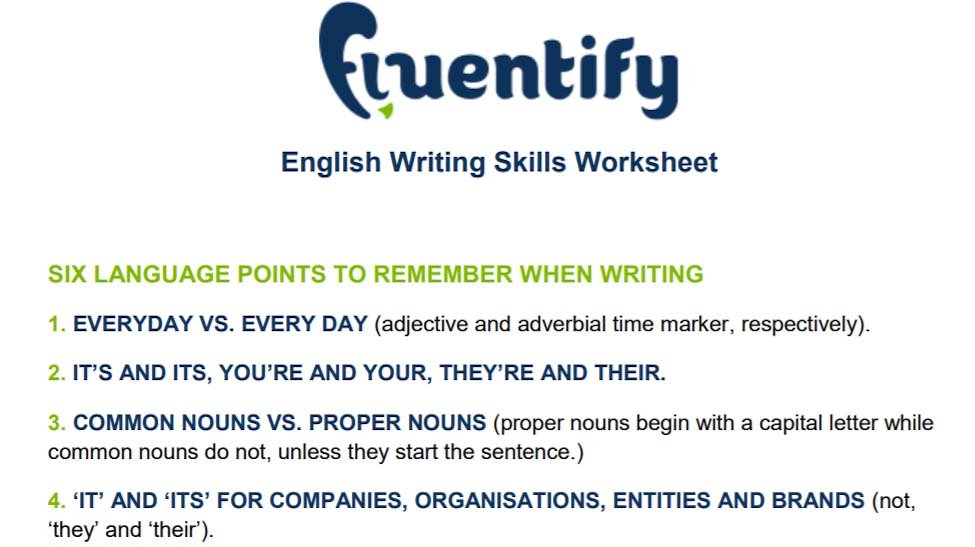Many students feel more comfortable writing English than speaking it. However, common writing errors mean that emails are perhaps not as polished or professional as your students would like.
Here are the six most common writing mistakes second language speakers make in writing and how to fix them. The post also includes a gap-fill exercise you can give to your student as homework, together with an answer key to check understanding.
Every day vs. everyday
‘Every day’ is an adverbial time marker which means the frequency in which you do something. For example:
‘Laura checks her emails every day.’
‘Everyday,’ on the other hand, is an adjective which means that something is common or used habitually. For example:
‘Traffic jams at rush hour are an everyday experience.’
It’s vs. its, you’re vs. your, and they’re vs. their
Many students confuse the contraction between the subject pronoun and ‘to be’ verb (it’s, you’re and they’re) and possessive adjectives (its, your, their).
How to fix it
If your student has doubts, ask them to say the word aloud while you’re writing it. Can it be separated into two words? For example: ‘They’re going for a picnic,’ can also be, ‘they are going for a picnic.’ If the answer is ‘yes,’ then it’s a contraction and needs an apostrophe. If the answer is ‘no,’ then it’s probably the possessive adjective.
Capitals: The ‘common noun’ vs. ‘proper noun’ problem
There are two types of nouns in English: common nouns and proper nouns.
A common noun is the name of a word. It can be the name of a person, place or thing. These nouns are NOT capitalised, unless they start a sentence. For example: ‘man,’ ‘city’ and ‘car.’
A proper noun is the particular name of a person, place or thing. These nouns ARE capitalised. For example: ‘Claudio,’ ‘Milan’ and ‘Mercedes.’
The problem
However, sometimes a common noun is capitalised. This happens when a common noun is inserted into a document to avoid the repetition of the proper noun. You see this a lot in legal documents such as work contracts. For example:
‘This letter outlines your contract of employment with Telefonica. Your employment with the Company will commence on the 1st April 2019.’
Here the word ‘company’ has substituted the name ‘Telefonica’ and so it is capitalised.
However, this does not mean that the word ‘company’ is a proper noun and should always be capitalised. It is a common noun and you shouldn’t capitalise it in normal sentences.
For example: ‘There are 40 major oil and gas companies in the world.’
How to fix it
Ask your student to think: ‘does this word substitute the name of something? Or, does it describe something?’ If it substitutes a name then it is capitalised, if it is a description then it is not capitalised.
Finally, remember that the days of the week and the months of the year are proper nouns in English and so they are capitalised.
This is a difficult language point to get right. Ask your student to practice with our worksheet below.
‘It’ for companies and organisations
Businesses, organisations, entities and brands are always singular and should be referred to as ‘it’ and not ‘they.’ For example:
‘McDonald’s is a multinational company. It is expanding further into the Asian market next year.’
Dates and numbers
Dates
When writing dates you eliminate ‘the’ and ‘of’ and write:
‘31st January 2019’ (if you’re writing to someone in the UK, Australia or New Zealand). Or,
‘January 31st 2019’ (if you’re writing to someone in the US or Canada).
Numbers
Write large numbers with a comma and not a point
Remember: Large numbers are separated by a comma in English, not a point.
For example: 1,327,564 (not, 1.327.564)
AND: Fractions are written with a decimal point in English, not a comma.
For example: 4.3 and 6.7 (not, 4,3 and 6,7).
Homework: Test your knowledge
Ask your student to test their understanding of these writing rules with this gap-fill worksheet. Your student can correct themselves using the answer key on the final page.


